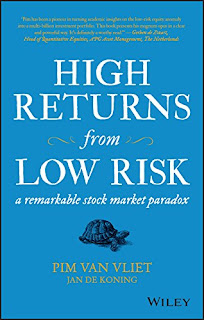
This ebook reveals a story about the stock market wich will change the way you think about investing. It is a story about a paradox I stumbled upon many years ago, one that still amazes me today. It is the story of an ‘inconvenient truth’ for economics professors as it turns their models upside down. A delusional story for professional investors who are managing other people’s money. It’s also a personal story which will make you smile and wonder. But most importantly, it’s a story that will help you become a better investor, as it describes how to turn scientific insights into profits. It is the modern stock market equivalent of ‘the tortoise and the hare’: a remarkable tale of how low-risk stocks beat high-risk stocks.
My goal is to explain this stock market paradox to you as I would explain it to my father. He is a retired businessman with stock market investing experience. Although he is not an expert in finance, he is a wise man with an entrepreneurial mindset. He has taught our family to respect classical virtues such as prudence, patience, and persistence. Over the years I have discovered that there is a close link between these principles and successful investing. By referring to his values, I will explain this paradox in an understandable way.
If my father can understand this story, you might understand it as well.
My wife is a surgeon, and her field of medicine has been transformed by the ‘evidencebased’ approach. Every pill she prescribes is extensively tested and empirically validated. You will agree that this makes sense, since it directly affects our physical health. However, when it comes to our financial health we are not yet that advanced. When somebody makes a profitable investment, it’s not so easy to explain whether it’s down to good luck or pure skill. Investors often quickly draw conclusions based on too little statistical evidence. Luckily, things are starting to change for the better. Evidence-based investing – applying thoroughly tested investment theories to portfolio construction – is on the rise. In this book I will apply this scientific approach to stock market investing and show you significant results that justify its effectiveness going back as far as 1929.
But this book is not all about science and applied wisdom. In fact, it starts with an impatient and overconfident teenager who tries his luck on the stock market. It’s the story of a young academic who stumbles upon a huge but puzzling investment paradox. Later, as an ambitious investment manager, he translates this academic theory into a multi-billion-dollar investment strategy. At each stage, he understands more and more about why low-risk stocks are shunned by most investors and how this behavior explains the existence of this paradox.
In today’s world you can rely less and less on government help in meeting your pension requirements, so the answer is to start investing yourself. For this reason, my father manages his own pension portfolio and I invest for my kids’ future. I hope this remarkable story about risk can help you take responsibility for your own financial wellbeing and that of others.
This is also why I believe that, after writing numerous academic research papers on this subject, it is time to tell the story to a broader audience of investors. People like my father and you. So I have written a book about this great stock market paradox that I hope is simple and easy to understand. Drawing on my experience as a researcher and fund manager, I will translate complex academic theory into a simple investment strategy, which you can directly implement to shape your financial future. This narrative is a story that I have told many times to thousands of investors in dozens of countries. But it is also my story, including a number of personal anecdotes. I hope it will be an entertaining read.
Oh, and don’t be surprised if you become a different kind of investor… Just smile and wonder!
As an Amazon Associate I earn from qualifying purchases.
Comments
Post a Comment